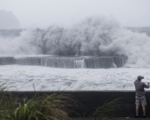Greek authorities have launched an emergency response to a growing earthquake swarm near Santorini, triggering the closure of schools and the deployment of emergency teams across the region. The tremors, which began last week, have steadily increased in frequency and strength, prompting fears of potentially more powerful earthquakes. The largest tremor recorded so far reached a magnitude of 5, striking around 34 kilometers northeast of Santorini at 2:27 p.m. local time, as reported by the University of Athens’ earthquake monitoring system. While the situation remains unpredictable, experts have ruled out an immediate volcanic eruption despite the heightened seismic activity.
Experts attribute the ongoing tremors to fault movement rather than volcanic unrest. Santorini, located on the tectonic boundary between the African and Eurasian plates, sits atop the submerged Santorini caldera, which has previously been a site of volcanic activity. According to David Pyle, a professor of Earth Sciences at the University of Oxford, the current swarm is more likely the result of tectonic fault lines shifting, rather than magma-related activity. He noted that the swarm’s underwater location adds complexity to predicting future seismic events, making it difficult to fully assess the potential risks.
The region’s geological activity is driven by the tectonic interaction between the African and Eurasian plates, which causes significant seismic events. Earthquake swarms are not uncommon in the area; however, this recent series is particularly notable for its intensity and location. A similar swarm was recorded between 2011 and 2012, which was linked to magma movement beneath Santorini. This current event, however, appears to be more expansive, with tremors concentrated mainly between the Kolumbo volcano and Anydros Island, both of which are located underwater.
As authorities continue to monitor the situation closely, the unpredictable nature of the swarm underscores the challenge of forecasting seismic activity in a region with such complex tectonic dynamics. While there is currently no immediate volcanic threat, the authorities remain on high alert, prepared to respond to any further developments as they occur.


















